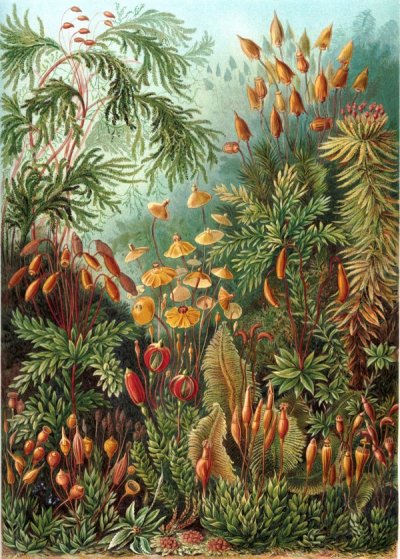
Also see: huge image and original image scan
Kunstformen der Natur (1904) Plate 72, by Ernst Haeckel - The MuscinaeNote: Muscinae is an obsolete scientific name for mosses -- the modern term is Bryophyta Artwork species key: For index to numbers, see here. Thamnium alopecurum (Linné) = Thamnobryum alopecurum (Hedw.) Nieuwl. ex Gangulee Eurhynchium praelongum (Linné) = Eurhynchium pumilum (Wilson) Schimp. Polytrichum commune (Linné) = Polytrichum commune Hedw. Sphagnum cymbifolium (Ehrhard) = Sphagnum palustre L. Splachnum luteum (Linné) = Splachnum luteum Hedw. Mnium undulatum (Hedwig) = Hypnum ligulatum F.Weber & D.Mohr Rhodobryum roseum (Schreber) = Rhodobryum roseum (Hedw.) Limpr. Physcomitrium acuminatum (Schleich.) = Physcomitrium eurystomum Sendtn. Physcomitrium ericetorum (Notaris) = Physcomitrium ericetorum (De Not.) Bruch & Schimp. Physcomitrium sphaericum (Schwaeg.) = Physcomitrium sphaericum (C.F. Ludw.) Fürnr. Sphagnum medium (Limpricht) = Sphagnum magellanicum Brid. Andreaea Thedenii (Schimper) = Andreaea obovata Thed. Hypnum castrense (Linné) = Hypnum crista-castrensis Hedw. Tetraplodon urceolatus (Schimper) = Tetraplodon urceolatus (Hedw.) Bruch & Schimp. Dissodon Hornschuchii (Greville) = Tayloria hornschuchii (Grev. & Arn.) Broth. Dissodon Froelichii (Hedwig) = Tayloria froelichiana (Hedw.) Mitt. ex Broth |
Darwin's Entangled BankThis is my favorite Haeckel illustration, probably because it reminds me of Darwin's words about an entangled bank. Darwin's entangled bank quote is particularly notable because the environmental context of natural selection is emphasized (“widely-different checks act on the same species in different districts”). Chance is thus, not a factor.
|